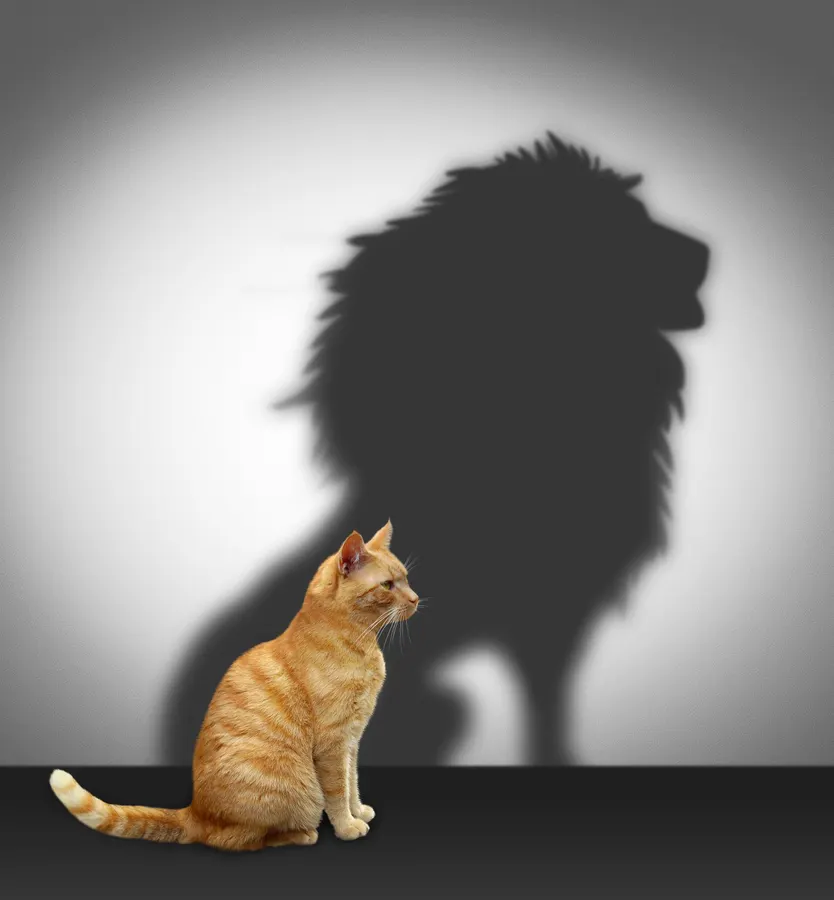Copyright Forbes

The iconic Cowardly Lion in The Wizard of Oz captured the essence of courage, as something that isn’t found, but instead forged. It’s a muscle we build through action, repetition, and risk. The Lion didn’t become courageous by receiving a medal; he became courageous by showing up, despite his fear, trembling and uncertain, again and again. That’s the truth we often overlook: courage isn’t a revelation—it’s a regimen. Courage isn’t always loud. It doesn’t always look like leaping from burning buildings or standing on podiums. More often, it shows up in quiet moments—the ones that ask us to speak up in a meeting, admit we don’t know, ask for help, say yes to something that scares us, or no to something that is not aligned with what we need to do. These aren’t headline-worthy acts, but they stretch us beyond the familiar and comfortable. They’re the daily reps that build courage. Because courage isn’t just summoned in emergencies—it’s exercised in the small, steady choices that nudge us out of our comfort zone and into growth. A lack of courage can have a profound impact on both individuals and organizations, often in quiet yet powerful ways. For individuals, it might mean staying silent when our voice could make a difference or choosing comfort over growth—slowly eroding confidence and integrity. For organizations, it shows up as avoiding tough decisions or protecting stability over progress. Over time, these small moments compound, stifling innovation, weakening trust, and dulling the sense of purpose that drives success. Building on the video introduction to the character dimension of courage provided by Corey Crossan, I unpack the character dimension of courage, why it matters, and how to develop it. Defining Courage To exercise and develop the muscle of courage, it is critical to understand what it is and how it can manifest in deficiency and excess. As Corey Crossan describes, “Courage is doing what’s right—even when it’s unpopular, actively discouraged, or comes at a personal cost. It’s the resolve to face fear rather than flee from it, to act on conviction rather than comfort. Those with courage show determination and confidence in the face of uncertainty. They rebound from setbacks, persevere through obstacles, and keep moving forward when the outcome is unclear. Courage isn’t the absence of fear—it’s the decision to move through it with purpose.” In its broadest sense, courage includes all its common types—moral, physical, and social courage. Each shares the same fundamental elements: being brave, confident, determined, resilient, and tenacious. MORE FOR YOU Forbes contributor Margie Warrell documents the deficiency of courage in her 2025 article “The Courage We Lack: When Fear Becomes Fatal. “One study found that 76% of people at work avoid conflict while a survey by Crucial Learning found that nearly 75% of employees regularly withhold concerns—even when doing so could prevent major problems. It’s why some of the biggest problems individuals and organizations face stem not with what was said—but with what wasn’t – due to fear of how it would impact their status. As history shows, when fear governs decisions, it generally leads to worse outcomes over time.” In a follow-up Forbes article by Warrell, “Courage As Currency: How Brave Cultures Outperform Safe Ones,” she draws on several studies to expose what she describes as “the hidden tax of fear,” which undermines culture. Understanding what courage is, how it can manifest in deficiency and excess, is a critical underpinning to developing a character-based culture, as I wrote in my 2025 Forbes article, “Seeing How Character Eats Culture For Breakfast.” A key insight connecting individual character with organizational culture is that culture reflects character, and a cornerstone of cultivating a psychologically safe context that encourages people to speak up and tackle things outside their comfort zone. Courage operates collectively and can be amplified or dampened. To exercise courage, it is critical to understand the foundational elements and how they can manifest as deficient and excess vices, as shown in Table 1. Although many people believe they are deficient in the courage behaviors, there are people who find themselves in the excess vice column. Although they would not necessarily describe themselves as reckless or arrogant, others often view them that way. The gap between viewing ourselves through positive intentions and others on their observable behavior is compounded by research revealing that most of us believe we are self-aware, but few are. The critical insight in character development is that you never want to diminish a strength, but instead need to strengthen the weaker dimensions that support the strength. Explore the Leader Character Framework to see the other 10 dimensions that support courage. In her video, Crossan describes courage as a bridge spanning a canyon, built plank by plank. “When Courage is underdeveloped, the bridge remains incomplete. Fear, hesitation, and avoidance keep you stranded on the edge. Opportunities drift by like clouds over the canyon. This is the deficient side of courage: hesitant, unassured, and fragile. Confidence weakens, and others may miss out too—the words they needed or the stand you could have taken never made it across. And when courage tips into excess, it turns into recklessness. You rush across before the bridge is ready. You ignore the guardrails, dismiss the risks, and mistake boldness for bravery. This is the excess side of courage: arrogant, reckless, and stubborn. While these behaviors can bring short-term gains, over time they erode trust and stability—and people can get hurt, including you.” Developing courage relies on understanding how to develop each of the underlying behaviors and how they are interconnected with other character dimensions. Developing Courage Drawing on research from exercise science, which focuses on a model of progression, character development can be understood through five levels. The first level is to learn about the behaviors associated with courage and to identify and observe them in yourself and others. Table 1 provides guidance on becoming a student of character by examining the deficient, virtuous, and excess states. Courage is a fascinating character dimension because many people discover that they exhibit behaviors in both deficient and excess states. As Crossan describes in her video, “For me, Courage often feels like a paradox. Others might see me tipping toward the excess side—stubborn, bull-headed, maybe even reckless at times. And they wouldn’t be entirely wrong. I recognize that drive to push through, that impatience to act, that resistance to slow down. Yet inside, I often feel the opposite—like I never have enough bravery, confidence, or resilience. It’s the tension reflected in my high drive and lower temperance that keeps me pushing forward, while underdeveloped humility leaves me questioning whether I’m enough. I still take action, but that imbalance makes courage feel harder won—more effortful than it should be. Over time, my relationship with fear has become more intimate. I’ve learned that fear isn’t something to conquer once and for all—it’s something to understand. Fear is often the signal that courage is required. But not all fear means the same thing. Some fears are red flags, warning us to pause or reconsider; others are invitations, urging us to step forward. Knowing the difference has become a crucial part of building courage—because discernment is what keeps bravery from becoming recklessness.” Having worked with thousands of students and executives on developing courage, specific insights emerge as consistent patterns. The first is the reflection that confidence is often fragile because it is anchored in competence and results, as opposed to the character one needs to navigate spaces where either competence feels insufficient or results are not forthcoming. The feeling that we are never good enough manifests in the “imposter syndrome” that many people fear. In my 2024 Forbes article “How to Combat Imposter Syndrome By Developing Character,” I reinforce Leslie Jamieson’s claim that the term imposter syndrome tends to mislead – we are neither imposters, nor is it a syndrome. Instead, the experience of doubt and discomfort arises because we are often “crossing thresholds” in systems that may not have been designed for us, which can make us feel like outsiders. As she described, “it is an inescapable part of being alive.” Competence alone does not help build the bridge that Corey Crossan described. Instead, it is the character that we need to forge one plank at a time as an inevitable part of life’s journey. However, there is often confusion around confidence in its excess state, which is arrogance. Some people have come to believe that arrogance is necessary and needed, for example, in sports. As Crossan describes: “But arrogance isn’t strength—it’s the overestimation of one’s abilities. And that arrogance can cloud judgment. Think of an athlete who misjudges their speed, convinced they can outrun their opponent, only to cost their team the game. It’s not confidence that drives that mistake—it’s arrogance without the humility to recognize and respect our limits.” The second insight is that, although considerable attention has been given to the need for resilience, few people grasp its reliance on other character behaviors. For example, a person will put less pressure on their resilience if they have stronger humility, meaning that they have less fear of making mistakes, are more vulnerable and open to learning, and thus view missteps as opportunities to learn rather than failures. And resilience can manifest in an excess vice state when people over-compensate by telling themselves or others that something doesn’t matter and they are over it. As Karol Truman famously wrote, “feelings buried alive never die,” meaning that strength in resilience is not about ignoring challenges, but learning how to process them. The final insight is around underestimating the pure tenacity and determination it takes to stick with something. Many people learn how easily they give up when the going gets tough or the task seems daunting. On the other hand, you can have so much tenacity and determination that it compromises your judgment to do anything but act in that way. Lacking temperance, for example, can lead to reckless behavior, simply because you are powered by such tenacity and determination that no obstacle will thwart your efforts. Building on the insights from the first level, Level 2 emphasizes activating courage through priming, reminding, and reinforcement. Lessons at this level use stories, videos, images, and music to help prompt and reinforce courage. An individual can gather these resources as inspiration to support the activation of courage. The Virtuosity Courage Music Playlist offers some examples. In our character workshops, the song “Eye of the Tiger” tends to be a favorite among many people, not just because of its lyrics and tempo, but also because of its association with Rocky, who epitomized determination and tenacity. Numerous stories and movies can inspire courage, and often these stories are unique to the individual, inspired by those close to us who have faced adversity in courageous ways. Level 3 becomes more challenging because it requires daily practice to exercise courageous behaviors. Some examples from the Virtuosity mobile app, which I co-created with Corey Crossan, include a set of daily exercises for strengthening resilience that draw on the science of resilience. The theme is to strengthen your resilience by bouncing forward – turning each setback into renewed strength. The practice of developing character starts with a daily intention that can shape the rest of the day. Rebound: When life dips — even slightly — use it as a chance to spring back. Shift your focus, take a breath, and keep moving. Each rebound strengthens your ability to rise higher. Reframe the Story: When frustration hits, view it from another angle. Ask, “How else could I see this?” The story you tell shapes how quickly you recover. Extract the Lesson: When you meet friction — a mistake, a misunderstanding, or a missed chance — look for what it’s teaching you. Each lesson builds inner strength. Reset the Routine: When your rhythm breaks, start again with intention. Recenter, adjust, or restore your focus. Every reset renews your momentum. Use Critique as Fuel: When feedback stings or tension appears, search for the truth that helps you improve. Turning resistance into energy is how resilience grows. Find the Better Way: When something feels off or inefficient, experiment. Explore a clearer, smoother, or smarter approach. Growth often hides inside small refinements. Focus Forward: When your mind lingers on what went wrong, let it go and return to what’s next. Moving forward keeps you light and rising. Level 4 focuses on connecting courage with the other character dimensions. As Crossan describes: “At times, I slip into bull-headedness—chasing ideas so hard I miss what’s right in front of me. That kind of courage can steer me off course when I overlook key inputs or forget to check if an idea really connects. My appetite for progress can eclipse perspective. In those moments, I need the grounding of other dimensions: temperance, to pause and consider other options; transcendence, to step back and see new possibilities; humility, to recognize my limits and ask for help; and collaboration, to draw on the strengths and perspectives of others.” Too often, we put way too much pressure on courage because we haven’t developed strength in other dimensions. The Canadian Armed Forces Ethos, highlights the critical underpinning of character and reinforces how courage relies on other dimensions, with the following quote revealing the connection to humility, accountability, and judgment: “Courage requires the willpower to see things through. It means making the best choice when faced with dilemmas, admitting our mistakes, and rectifying them to maintain trust.” Level 5 is particularly challenging because it requires us to examine the various contexts that test our courage. The strength of courage means that it remains consistent across multiple contexts, rather than being situational. For example, in Level 3, the practice of developing courage to engage difficult conversations is challenged when considering the classic context of “speaking truth to power.” Although it takes courage to have a difficult conversation with a colleague or loved one, having that conversation with someone who may hold significant power over us increases the demand on courage. Social context can challenge courage. At home in front of the mirror, we have the courage to practice a speech, but in front of a crowd, we might freeze. The reason courage is often qualified as moral, physical, and social is to highlight the nature of courage and the contexts that challenge it. Returning to imposter syndrome, confidence is challenged in the context of crossing thresholds. Understanding the required strength of courage across various contexts also reveals an opportunity to cultivate environments that foster courage, as exemplified by psychological safety. Even though courage has long been valued, our workshops reveal that most people feel their culture isn’t supportive of courage, often because people get penalized when they question ideas, expose problems, or offer new approaches. The answer is to develop a character-based culture through character development, as I describe in the article “Character Eats Culture For Breakfast.” This means not just focusing on developing courage, but all the character dimensions that impact culture. In summary, as Crossan describes, “Courage isn’t about getting rid of fear. It’s about embracing it—and choosing to move forward anyway. And it’s not about taking one giant leap across the canyon. It’s about laying one plank at a time: to raise your hand, to speak an unpopular truth, to start something new, or to keep going when it would be easier to stop.”



